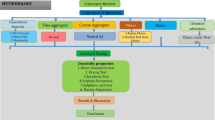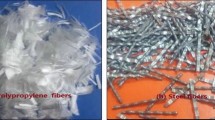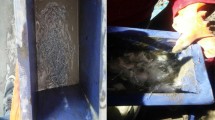Abstract
The high-strength concrete having a better compressive strength demeanor can be manufactured by the addition of the fibers which eliminates the inherent weakness, the brittle failure due to lack of tensile strength. In this study, an experimental study covering the enhancement of the mechanical characteristics and the investigation of the performance against the aggressive acid attack of high-performance cementitious composites (HPCC). For this, steel and glass types of fiber were employed in the manufacturing of HPCC, as either single or hybrid at various levels. The HPCC mixtures were designed at a constant water-to-cementitious ratio of 0.25. Portland cement and microsilica were employed in the manufacturing as cementitious material whereas the aggregate was the mix of river and quartz sands. 14 HPCC mixtures were designed and the flowability, unit weight, compressive and flexural strengths, sorptivity index, ultrasonic pulse velocity were tested at various ages. Besides, the loss in the strength, mass, and dimension of HPCC mixtures was also measured after exposure of the mixtures 1- and 2-month aggressive sulfuric acid (H2SO4). Additionally, the experimental results were statistically evaluated through general linear model ANOVA. Based on the results, the highest compressive strength values were observed in the HPCC mixture manufactured with steel fiber. The lowest losses in both flexural and compressive strengths were observed in the mixtures produced with microsilica. Steel fiber addition increased the compressive strength not only after applying the normal curing regime but also after exposing the sulfuric acid. Both flexural and compressive strength of HPCC mixtures were influenced by fiber type and volume fraction. The addition of glass fiber decreased compressive strength.














Similar content being viewed by others
References
Anand A, Jose M. Study of hardened properties of hybrid fibre reinforced concrete using steel and glass fibre. IOP Conf Ser Mater Sci Eng. 2019;396(1): 012004. https://doi.org/10.1088/1757-899X/396/1/012004.
Kumar R, Dhaka EJ. Partial replacement of cement with silica fume and its effects on concrete properties. Int J Technol Rese Eng. 2016;4(1):86–88. http://www.ijtre.com/images/scripts/2016040120.pdf. Accessed 14 Jan 2021.
Ayub T, Khan SU, Memon FA. Mechanical characteristics of hardened concrete with different mineral admixtures: a review. Sci World J. 2014. https://doi.org/10.1155/2014/875082.
Yew MK. Mechanical properties and impact resistance of hybrid fibre-reinforced high strength concrete. Doctoral Dissertation, Jabatan Kejuruteraan Awam, Fakulti Kejuruteraan, Universiti Malaya, 2012.
Kanagavel R, Arunachalam K. Experimental investigation on mechanical properties of hybrid fiber reinforced quaternary cement concrete. J Eng Fibers Fabr. 2015;10(4):139–48. https://doi.org/10.1177/155892501601100301.
Patil TR, Burile AN. Comparative study of steel and glass fiber reinforced concrete composites. Int J Sci Res. 2013;5(5):690–4.
Chandramouli K, Srinivasa RP, Pannirselvam N, Seshadri ST, Sravana P. Strength properties of glass fiber concrete. ARPN J Eng Appl Sci. 2010;5(4):20–30.
Ravikumar CS, Thandavamoorthy TS. Glass fibre concrete: investigation on strength and fire resistant properties. ISOR J Mech Civ Eng (IOSR-JMCE). 2011;9:21–5. https://doi.org/10.9790/1684-0932125.
Sukumar A, John E. Fiber addition and its effect on concrete strength. Int J Innov Res Adv Eng (IJIRAE). 2014;1(8):144–9.
Kushartomo W, Ivan R. Effect of Glass Fiber on Compressive, Flexural and spliting strength of reactive powder concrete. MATEC Web Conf. 2017;138:03010. https://doi.org/10.1051/matecconf/201713803010.
Sumathi A, Mohan KSR. Effect of steel fiber on structural characteristics of high-strength concrete. Iran J Sci Technol Trans Civ Eng. 2019;43(1):117–30. https://doi.org/10.1007/s40996-018-0152-x.
Singh NK, Rai B. A Review of fiber synergy in hybrid fiber reinforced concrete. J Appl Eng Sci. 2018;8(2):41–50. https://doi.org/10.2478/jaes-2018-0017.
Sarangi S, Sinha AK. Mechanical properties of hybrid fiber reinforced concrete. Indian J Sci Technol. 2016;9(30):1–4. https://doi.org/10.17485/ijst/2016/v9i30/99234.
Vairagade VS, Kene KS. Experimental investigation on hybrid fiber reinforced concrete. Int J Eng Res Appl. 2012;2(3):1037–41.
Vineetha VV, Arya A. Mechanical properties of hybrid fibre reinforced concrete using recycled aggregate. Int J Adv Sci Res Eng. 2017;03(5):244–7.
Persson B. Self-desiccation and its importance in concrete technology. Mater Struct. 1997;30(5):293–305. https://doi.org/10.1007/BF02486354.
Shen D, Liu C, Li C, Zhao X, Jiang G. Influence of Barchip fiber length on early-age behavior and cracking resistance of concrete internally cured with super absorbent polymers. Constr Build Mater. 2019;214:219–31. https://doi.org/10.1016/j.conbuildmat.2019.03.209.
Annadurai A, Ravichandran A. Investigation on mechanical properties of hybrid fiber reinforced high strength concrete. Int J Eng ResTechnol (IJERT). 2013;2(12):2439–2446.
Ravikumar CS, Ramasamy V, Thandavamoorthy TS. Effect of fibers in concrete composites. Int J Appl Eng Res. 2015;10(1):419–30.
Kim KC, Yang IH, Joh C. Effects of single and hybrid steel fiber lengths and fiber contents on the mechanical properties of high-strength fiber-reinforced concrete. Adv Civ Eng. 2018. https://doi.org/10.1155/2018/7826156.
Shen D, Liu X, Zeng X, Zhao X, Jiang G. Effect of polypropylene plastic fibers length on cracking resistance of high performance concrete at early age. Constr Build Mater. 2020;244: 117874. https://doi.org/10.1016/j.conbuildmat.2019.117874.
Drzymała T, Jackiewicz-Rek W, Tomaszewski M, Kuś A, Gałaj J, Šukys R. Effects of high temperature on the properties of high performance concrete (HPC). Proc Engg. 2017;172:256–63. https://doi.org/10.1016/j.proeng.2017.02.108.
Pedro D, De Brito J, Evangelista L. Mechanical characterization of high performance concrete prepared with recycled aggregates and silica fume from precast industry. J Clean Prod. 2017;164:939–49. https://doi.org/10.1016/j.jclepro.2017.06.249.
Wang D, Ju Y, Shen H, Xu L. Mechanical properties of high-performance concrete reinforced with basalt fiber and polypropylene fiber. Constr Build Mater. 2019;197:464–73. https://doi.org/10.1016/j.conbuildmat.2018.11.181.
Joorabchian SM. Durability of concrete exposed to sulfuric acid attack. MASc Dissertations. Presented to Ryerson University, Toronto, Ontario, Canada, 2010.
Richardson MG. Fundamentals of durable reinforced concrete. 1st ed. CRC Press; 2002.
Mahdikhani M, Bamshad O, Shirvani MF. Mechanical properties and durability of concrete specimens containing nano silica in sulfuric acid rain condition. Constr Build Mater. 2018;167:929–35. https://doi.org/10.1016/j.conbuildmat.2018.01.137.
Salman MM, Zghair LAG. Behavior of self-compacting concrete subjected to sulphuric acid. J Eng Sustain Dev. 2018;22(5):1–9. https://doi.org/10.31272/jeasd.2018.5.1.
Marcos-Meson V, Fischer G, Edvardsen C, Skovhus TL, Michel A. Durability of steel fibre reinforced concrete (SFRC) exposed to acid attack—a literature review. Constr Build Mater. 2019;200:490–501. https://doi.org/10.1016/j.conbuildmat.2018.12.051.
Taku KJ, Amartey DY, Kassar T. Effect of acidic curing environment on the strength and durability of concrete. Civ Environ Res. 2015;7(12):8–13.
Barbhuiya S, Kumala D. Behaviour of a sustainable concrete in acidic environment. Sustainability. 2017;9(9):1556–69. https://doi.org/10.3390/su9091556.
Mahmoodian M, Alani AM. Effect of temperature and acidity of sulfuric acid on concrete properties. J Mater Civ Eng. 2017;29(10):04017154. https://doi.org/10.1061/(ASCE)MT.1943-5533.0002002.
ASTM C 33-18. Standard specification for concrete aggregates. West Conshohocken: ASTM International; 2018. https://doi.org/10.1520/C0109_C0109M-20B.
ASTM C1437-20. Standard Test Method for Flow of Hydraulic Cement Mortar. West Conshohocken: ASTM International; 2020. https://doi.org/10.1520/C1437-20.
ASTM C138/C138M-17a. Standard test method for density (unit weight), yield, and air content (Gravimetric) of concrete. West Conshohocken: ASTM International; 2017. https://doi.org/10.1520/C0138_C0138M-17A.
ASTM C109/C109M-20b. Standard test method for compressive strength of hydraulic cement mortars (Using 2-in or [50 mm] Cube Specimens). West Conshohocken: ASTM International; 2020. https://doi.org/10.1520/C0109_C0109M-20B.
ASTM C78/C78M-18. Standard test method for flexural strength of concrete (Using Simple Beam with Third-Point Loading). West Conshohocken: ASTM International; 2018. https://doi.org/10.1520/C0078_C0078M-18.
ASTM C597-16. Standard test method for pulse velocity through concrete. West Conshohocken: ASTM International; 2016. https://doi.org/10.1520/C0597-16.
ASTM C1585-20. Standard test method for measurement of rate of absorption of water by hydraulic-cement concretes. West Conshohocken: ASTM International; 2020. https://doi.org/10.1520/C1585-20.
ASTM C267-20. Standard test methods for chemical resistance of mortars, grouts, and monolithic surfacings and polymer concretes. West Conshohocken: ASTM International; 2020. https://doi.org/10.1520/C0267-20.
Almola EAAF. Effect of Silica Fume and Steel Fibers on the Hardened Concrete Properties. Doctoral dissertation, Sudan University of Science and Technology, 2018.
Johari MM, Brooks JJ, Kabir S, Rivard P. Influence of supplementary cementitious materials on engineering properties of high strength concrete. Constr Build Mater. 2011;25(5):2639–48. https://doi.org/10.1016/j.conbuildmat.2010.12.013.
De Gutiérrez RM, Diaz LN, Delvasto S. Effect of pozzolans on the performance of fiber-reinforced mortars. Cem Concr Compos. 2005;27(5):593–8. https://doi.org/10.1016/j.cemconcomp.2004.09.010.
Shekarchi M, Rafiee A, Layssi H. Long-term chloride diffusion in silica fume concrete in harsh marine climates. Cem Concr Compos. 2009;31(10):769–75. https://doi.org/10.1016/j.cemconcomp.2009.08.005.
Amudhavalli NK, Mathew J. Effect of silica fume on strength and durability parameters of concrete. Int J Eng Sci Emerg Technol. 2012;3(1):28–35. https://www.ijeset.com/media/4N5-IJESET0202520.pdf. Accessed 17 Jan 2021.
Kurashige I. Mechanism and prediction method for deterioration of concrete due to sulfuric Acid. Doctoral Dissertation in Tokyo University, Japan, 2002.
Aravindhan J, Vijayakumar G. Studies on strength characteristics of reactive powder concrete. Int J Chem Sci. 2016;14(S1):149–54.
Hwang CL, Bui LAT, Lin KL, Lo CT. Manufacture and performance of lightweight aggregate from municipal solid waste incinerator fly ash and reservoir sediment for self-consolidating lightweight concrete. Cement Concr Compos. 2012;34(10):1159–66. https://doi.org/10.1016/j.cemconcomp.2012.07.004.
Funding
This study was not funded by any supporter.
Author information
Authors and Affiliations
Corresponding author
Ethics declarations
Conflict of interest
The authors declare that they have no known competing financial interests or personal relationships that could have appeared to influence the work reported in the paper.
Additional information
Publisher's Note
Springer Nature remains neutral with regard to jurisdictional claims in published maps and institutional affiliations.
Rights and permissions
About this article
Cite this article
Mermerdaş, K., İpek, S., Anwer, A.M. et al. Durability performance of fibrous high-performance cementitious composites under sulfuric acid attack. Archiv.Civ.Mech.Eng 21, 147 (2021). https://doi.org/10.1007/s43452-021-00298-0
Received:
Revised:
Accepted:
Published:
DOI: https://doi.org/10.1007/s43452-021-00298-0




